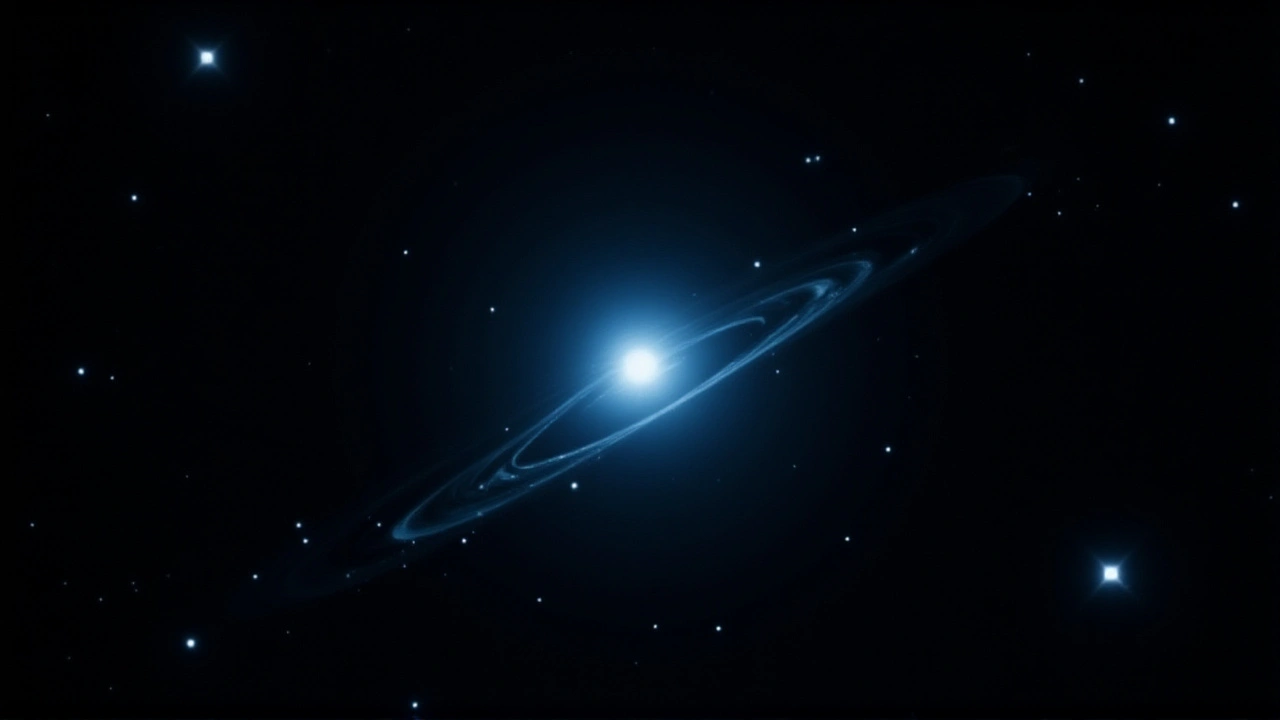When comet 3I/ATLAS whizzed past Mars on 3 October 2025, the race was on to photograph it in the sharpest detail ever recorded from another planet.
A rare interstellar pass over the Red Planet
At a closest approach of roughly 30 million km, the comet’s brief window offered a perspective no ground‑based telescope could match. 3I/ATLAS is only the third confirmed interstellar visitor, joining ‘Oumuamua (2017) and comet Borisov (2019). Unlike its predecessors, astronomers spotted it early enough – the ATLAS survey telescope in Rio Hurtado, Chile logged the first detection on 1 July 2025 and sent the data to the Minor Planet Center.
Pre‑covery images from three ATLAS sites and Caltech’s Zwicky Transient Facility at Palomar Observatory pushed the observation arc back to 14 June 2025, allowing orbital calculations that revealed its hyperbolic trajectory. Tracing the path backwards shows the object originated well beyond the Sun’s sphere of influence, confirming its interstellar nature.
NASA’s HiRISE takes the lead
The Mars Reconnaissance Orbiter (MRO) swung its powerful HiRISE camera into position. HiRISE, a half‑metre telescope normally used to resolve features as small as a meter on the Martian surface, will be imaging the comet from a distance of about 29 million km. That translates to a spatial resolution of roughly 30 km per pixel – enough to pick out brightness variations in the coma and subtle ripples in the tail caused by solar magnetic interactions.
"We’re pushing HiRISE beyond its usual playground," said Avi Loeb, a Harvard astrophysicist who has long argued that interstellar objects could be larger than they appear. While most estimates peg the nucleus at about one kilometre across, Loeb’s calculations allow for a diameter exceeding five kilometres. If HiRISE can catch a faint change in the coma’s shape, it may help settle that debate.
The instrument will also be looking for any unexpected dust spikes that could reveal the comet’s composition. With the spacecraft circling Mars every two hours, the camera can capture a series of shots over the comet’s transit, building a time‑lapse of its interaction with the solar wind.
ESA mobilises Mars Express and TGO
Not to be outdone, the European Space Agency redirected two of its ageing orbiters. Mars Express, launched in 2003, swapped its usual atmospheric studies for a quick stare at the comet. Its HRSC camera, though less sharp than HiRISE, can provide a broader field of view to capture the tail’s full length.
Meanwhile, the ExoMars Trace Gas Orbiter (TGO) switched on its NOMAD spectrometer to sniff out gas emissions. By measuring the spectral fingerprints of water, carbon monoxide and other volatiles, scientists hope to compare the comet’s chemistry with that of Borisov, which was unusually rich in carbon‑bearing molecules.
"ESA’s strength lies in its suite of complementary instruments," noted Dr. Marta Hernandez, the mission’s science coordinator. "Even if our images aren’t as crisp, the combined spectroscopic data will paint a fuller picture of what this visitor is made of."
International collaboration and other players
China’s Tianwen‑1 orbiter also earmarked a few observation slots, and NASA’s Perseverance rover captured a fleeting glimpse of the comet as a bright streak in the Martian night sky on 4 October. While the rover’s Mastcam‑Z cannot resolve the comet, the image provides a unique context: it shows how the object appeared to a surface‑based observer.
The coordinated effort mirrors the global response to the 2019–2020 comet Borisov fly‑by, when agencies shared data in near real‑time. In this case, the early discovery gave planners weeks rather than days, allowing a more deliberate choreography of observation windows.
What scientists hope to learn
Beyond the headline‑grabbing photos, the campaign aims to answer three big questions:
- Size and shape: Can high‑resolution imaging detect a faint nucleus silhouette or at least constrain its dimensions?
- Composition: Do spectroscopic signatures from TGO and any concurrent ground‑based facilities reveal an unusual mix of ices?
- Interaction with solar wind: Do the tail ripples observed by HiRISE match models of magnetic field draping around interstellar bodies?
Answering these will feed directly into theories about how material forms in other stellar systems. If 3I/ATLAS turns out to be larger or chemically distinct from Borisov, it could hint at a wider diversity of planetary building blocks across the galaxy.
Future outlook
After its closest approach to the Sun on 30 October 2025 at roughly 1.4 AU, the comet will speed away, disappearing from telescopes by early 2026. The data harvested this month will likely keep researchers busy for years, much like the wealth of papers that followed ‘Oumuamua’s brief visit.
For now, the world watches two sets of eyes in orbit around another world, each hoping to snap a piece of the cosmic puzzle. Whether HiRISE’s 30‑kilometre‑per‑pixel snapshots or ESA’s broader spectroscopic sweep yields the headline result, the mission underscores a new era: interstellar visitors can be studied not just from Earth, but from the eyes of our robotic scouts on neighboring planets.
Frequently Asked Questions
How does the 3I/ATLAS fly‑by affect future interstellar object missions?
The close Mars pass shows that orbiters can act as opportunistic observatories, meaning future missions may include dedicated instruments for interstellar targets, reducing reliance on Earth‑based telescopes alone.
What makes HiRISE’s observations different from ESA’s cameras?
HiRISE offers a finer spatial resolution (about 30 km/pixel at the comet’s distance) whereas ESA’s HRSC provides a wider field of view, capturing the full tail but with less detail.
Is there any risk that 3I/ATLAS could impact Mars or Earth?
No. The comet’s trajectory keeps it well clear of both planets – it passes Mars at 30 million km and will miss Earth by about 1.8 AU, posing no collision threat.
Why do scientists argue about the comet’s size?
Brightness alone can be misleading; a dark, matte surface appears fainter than a reflective one. Avi Loeb’s larger size estimate assumes low albedo, while most models use typical comet reflectivity, yielding a ~1 km diameter.
What kind of data will the ExoMars Trace Gas Orbiter provide?
TGO’s NOMAD spectrometer will record the infrared absorption lines of gases released by the comet, helping to identify water, carbon‑bearing compounds, and possible organic molecules.




It’s fascinating how the HiRISE instrument can resolve 30 km per pixel from that distance it shows the power of orbital assets and also reminds us that interstellar objects provide rare calibration points for our imaging pipelines. The data will likely improve our models of cometary activity far better than any ground‑based effort could manage. Plus the fact that multiple agencies coordinated this effort highlights the growing collaborative culture in planetary science.
One must commend the United States for leading the charge with HiRISE; its superior resolution undeniably outstrips the European hardware, reinforcing America’s preeminence in deep‑space observation. While ESA contributes, the decisive imagery will unquestionably come from our own assets, as history of space exploration has repeatedly demonstrated.
The deployment of HiRISE at a 29‑million‑km standoff provides a nominal spatial resolution of ~30 km pixel⁻¹, which is adequate to resolve coma brightness gradients and infer nucleus size constraints via photometric modeling. Concurrently, the HRSC aboard Mars Express, despite its coarser angular resolution, offers a wide‑field context critical for tail morphology analysis. TGO’s NOMAD spectrometer will acquire high‑resolution infrared spectra, enabling retrieval of volatile abundances through line‑by‑line radiative transfer inversion. By integrating the HiRISE photometry with NOMAD’s spectroscopic column densities, one can perform a multifaceted compositional assessment, distinguishing water‑ice signatures from carbon‑bearing species such as CO and CO₂. The Perseverance MastCam‑Z observation, albeit low‑resolution, furnishes an in‑situ perspective that may calibrate absolute brightness models. From a dynamical standpoint, the solar‑wind interaction region will be probed through tail rippling patterns captured by HiRISE; magnetohydrodynamic simulations predict characteristic draping signatures contingent upon cometary outgassing rates. The combined dataset will allow Bayesian inference of the nucleus albedo, informed by the flux‑density relationship and the assumed phase function of typical cometary dust. Moreover, cross‑comparison with Borisov’s spectroscopic catalog will test hypotheses regarding interstellar chemical diversity. The anticipated data volume necessitates robust pipeline development, involving de‑convolution algorithms to mitigate point‑spread‑function effects at extreme ranges. Finally, the collaborative framework established here sets a precedent for future opportunistic observations of interstellar interlopers, potentially prompting the inclusion of dedicated comet‑tracking modes in upcoming orbiter missions.
Isn't it just awe‑inspiring, the way humanity reaches across the void, eyes fixed on a wandering stone, and yet we forget the moral imperative to steward our own planet?; we celebrate technological triumphs while the very ecosystems we cherish gasp for air-such paradox!; the comet, a messenger from another star, reminds us that we are but fleeting visitors in a cosmic sea, and therefore we must act with humility, compassion, and responsibility, not only toward distant worlds but toward the Earth beneath our feet.
The observations described exemplify a balanced approach: HiRISE supplies high‑resolution imaging, whereas HRSC and NOMAD contribute complementary spatial and spectroscopic coverage. This synergy enhances the overall scientific return and mitigates the limitations inherent to any single instrument.
Looks cool but I bet the data won't change much, just more pictures of a rock flying by.
What a wonderful example of international cooperation!; sharing data across continents enriches our understanding and fosters goodwill among nations; may this spirit continue in future explorations.
Nice work! :)
One must appreciate the subtleties of the data pipeline, for without rigorous statistical deconvolution the purported "high‑resolution" claims remain little more than marketing hyperbole. The noise floor, the point‑spread function, the sampling theorem-all are often glossed over in popular accounts, yet they dictate the fidelity of any scientific inference drawn from such images.
While the effort is commendable the actual scientific payoff will likely be marginal given the limited resolution at such distance.
It seems the post overlooks the fact that the spectral resolution of NOMAD may be insufficient to resolve narrow organic features, which could lead to ambiguous compositional conclusions.
Wow, the excitement is palpable-imagine the thrill of watching a visitor from another star the size of a city, its tail rippling like a cosmic flag! This is the kind of moment that fuels dreams and pushes us to explore further.
It's great to see everyone working together; hopefully the results will benefit the whole scientific community.
We remain optimistic that the collaborative observations will yield valuable insights, and we look forward to the forthcoming analyses with great anticipation.
Sure, the images are nice, but let's not pretend this changes anything fundamental about our understanding of comets.